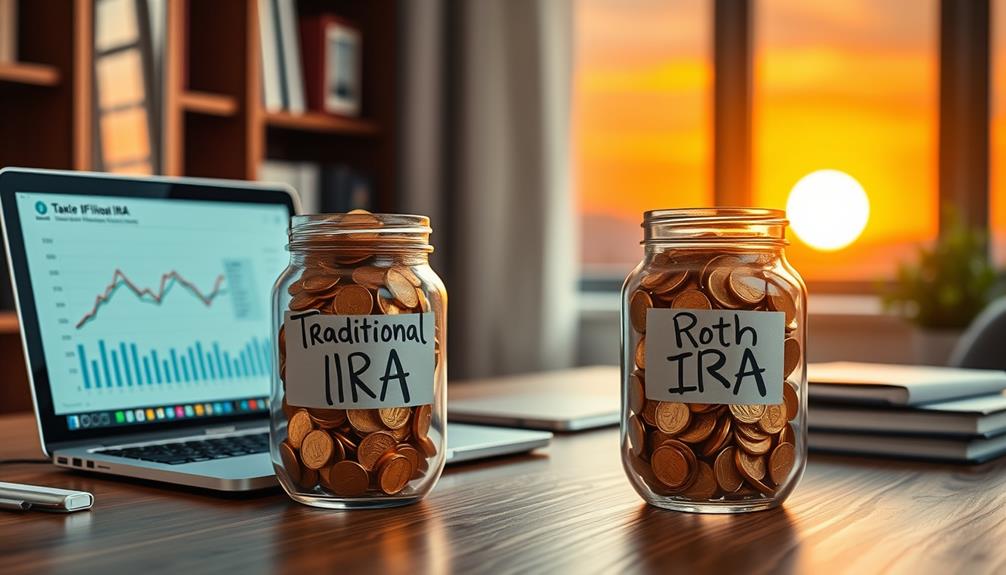As a small business owner, you have a variety of IRA options available to help increase your retirement savings. Consider a SEP IRA, which allows contributions up to 25% of your compensation, or a Solo 401(k), where you can contribute as much as $69,000 in 2024. If you prefer a simpler choice, a SIMPLE IRA allows you to defer up to $15,500 annually. Additionally, don’t overlook Traditional and Roth IRAs, each offering unique tax advantages. By carefully planning your strategy and understanding contribution limits, you can significantly enhance your retirement savings. Continue to explore and maximize the potential of these retirement accounts for your financial future.
Key Takeaways
- Small business owners can maximize retirement savings through SEP IRAs, allowing contributions up to 25% of compensation or $66,000 in 2024.
- Solo 401(k)s offer high contribution limits of up to $69,000 in 2024, combining both employee and employer contributions for maximum savings.
- SIMPLE IRAs allow employee contributions up to $15,500 in 2024, with employer matching options to enhance overall retirement savings.
- Traditional and Roth IRAs provide different tax advantages, with contribution limits of $7,000 in 2024, plus catch-up contributions for those 50+.
- Utilizing catch-up contributions and understanding tax benefits can significantly enhance retirement savings potential for small business owners.
Projected Retirement Income Needs

When planning for retirement, understanding your projected income needs is vital. Your income requirements will be influenced by factors like your retirement age, life expectancy, and the income sources you have, such as Social Security and investments.
To achieve financial freedom, you must assess the difference between your expected spending and projected retirement income needs. This gap highlights how much you need to save to maintain your desired living standards. Additionally, considering options like an IRA rollover to gold can be a strategic move to protect your assets against inflation and market fluctuations.
Inflation can further complicate your retirement savings plan. With an annual rate of around 4%, the purchasing power of your savings can erode considerably over time. It's essential to account for these changes when calculating your income needs.
Your income requirements may vary widely, from hundreds of thousands to millions, depending on your lifestyle choices and individual circumstances. Key considerations include how much you plan to withdraw annually, how long you expect to be retired, and your anticipated investment earnings or losses.
Common Retirement Plans Overview

How can you navigate the myriad of retirement plans available to small business owners? Understanding your options is key to maximizing your retirement savings.
To effectively plan, consider consulting a financial expert for tailored guidance on common financial terms.
Here's a quick overview of three popular plans:
- SEP IRAs: Ideal for self-employed individuals, you can contribute up to 25% of your compensation or $66,000 in 2024. This plan offers flexibility, allowing you to adjust contributions based on your business income.
- SIMPLE IRAs: This plan allows both employee and employer contributions, with employee deferral limits set at $15,500 in 2024. If you're 50 or older, you can add a catch-up contribution of $3,500, making it a great option for those wanting to save more.
- Solo 401(k)s: Perfect for self-employed individuals with no employees, you can contribute up to $69,000 in 2024. This includes both employee and employer contributions, providing high savings potential.
- Traditional and Roth IRAs: While these aren't the focus here, they're worth noting for their tax-deductible contributions and tax-free withdrawals, respectively.
Choosing the right plan can help secure your financial future.
Traditional and Roth IRAs

When considering your retirement options, understanding the differences between Traditional and Roth IRAs is essential. Each offers distinct tax advantages, contribution limits, and eligibility criteria that can greatly impact your savings strategy.
For small business owners, incorporating strategies such as a Gold IRA can further diversify retirement portfolios and enhance tax advantages.
Let's break down these key points to help you choose the right plan for your needs.
Tax Advantages Explained
The tax advantages of Traditional and Roth IRAs can greatly impact your retirement savings strategy. Understanding these benefits helps you make informed decisions that align with your financial goals.
For small business owners, exploring options like a Noble Gold Gold IRA can further enhance your investment potential. Here's a breakdown of key advantages:
- Tax Deductions: Contributions to a Traditional IRA may be tax-deductible, lowering your taxable income for the year. In contrast, Roth IRA contributions are made with after-tax dollars, so you won't receive a current-year deduction.
- Withdrawal Taxation: Withdrawals from a Traditional IRA are taxed as ordinary income in retirement, which can affect your tax bracket. However, qualified withdrawals from a Roth IRA are tax-free, offering potential tax savings down the line.
- Contribution Limits: For 2024, both Traditional and Roth IRAs allow contributions of $7,000, with an additional $1,000 catch-up contribution for those aged 50 and older.
- Income Eligibility: Be aware that Roth IRA contributions are subject to income limits, which can impact your ability to contribute based on your modified adjusted gross income.
Contribution Limits Overview
Understanding contribution limits is essential for maximizing your retirement savings, especially when you're a small business owner. For 2024, both Traditional and Roth IRAs allow you to contribute up to $7,000. If you're 50 or older, you can make an additional catch-up contribution of $1,000.
Here's a quick overview of the contribution limits:
| Account Type | Contribution Limit (Under 50) | Contribution Limit (50 and Older) |
|---|---|---|
| Traditional IRA | $7,000 | $8,000 |
| Roth IRA | $7,000 | $8,000 |
It's important to note that Roth IRAs have income eligibility limits, phasing out for single filers with modified adjusted gross incomes above $138,000 and for married couples filing jointly above $218,000. While contributions to Traditional IRAs may be tax-deductible, Roth IRA contributions are made with after-tax dollars, leading to tax-free withdrawals in retirement. By understanding these contribution limits, you can better strategize your retirement savings and make the most of your options through both Traditional and Roth IRAs.
Eligibility Criteria Insights
For small business owners, knowing the eligibility criteria for Traditional and Roth IRAs is essential in making informed retirement planning decisions. Understanding these criteria helps you maximize your retirement savings effectively.
Additionally, exploring gold IRA rollovers can provide a secure option for diversifying your retirement portfolio. Here are some key points to examine:
- Age Limits: You can contribute up to $6,500 to a Traditional IRA if you're under 50, or $7,500 if you're 50 or older due to catch-up contributions.
- Income Limits: For Roth IRAs, if your modified adjusted gross income (MAGI) exceeds $153,000 (single) or $228,000 (married), you can't contribute directly.
- Tax Deductibility: Contributions to a Traditional IRA may be tax-deductible based on your income and whether you participate in an employer-sponsored retirement plan, while Roth contributions are made with after-tax dollars.
- Rollover Flexibility: You can roll over funds from a former employer's 401(k) into either IRA type without penalty, enhancing your savings options.
Solo 401(k) and SEP IRA

Exploring retirement options like a Solo 401(k) and SEP IRA can greatly benefit small business owners looking to save for the future. A Solo 401(k) allows you to contribute up to $69,000 in 2024, which includes a $7,500 catch-up contribution if you're aged 50 or older.
You can combine employee salary deferrals and employer contributions, maximizing your retirement savings. Additionally, these strategies can serve as a form of diversification in your portfolio, similar to gold investment strategies, providing protection against market volatility.
On the other hand, a SEP IRA enables you to contribute up to 25% of your compensation or $66,000 in 2024. This flexibility lets you adjust contributions based on your business's annual earnings.
However, keep in mind that SEP IRAs don't allow employee contributions; all contributions come from you as the employer, simplifying your administrative tasks.
Both options offer tax-deferred growth, meaning your investments can grow without immediate tax implications until you withdraw them during retirement.
While a Solo 401(k) gives you the option to take loans against your account balance, a SEP IRA doesn't provide this feature. By understanding these options, you can make informed choices to enhance your retirement savings strategy.
SIMPLE IRA and Defined Benefit Plans

While Solo 401(k)s and SEP IRAs are popular choices among small business owners, a SIMPLE IRA and Defined Benefit Plan also present valuable retirement savings options.
Both plans offer unique features that may align with your business goals and employee needs. Here's what you should know:
1. SIMPLE IRA: Designed for businesses with 100 or fewer employees, it allows employee contributions of up to $15,500 in 2023, plus a $3,500 catch-up for those aged 50 and older.
Additionally, it's crucial to research gold IRA scams to guarantee your business is making safe investment choices.
2. Employer Contributions: You can choose to match employee contributions up to 3% of compensation or make a non-elective contribution of 2% for all eligible employees.
3. Defined Benefit Plan: This plan guarantees retirement payouts based on a formula considering salary and years of service, ideal for high earners.
4. Significant Contribution Limits: For older participants, contributions can exceed $200,000 annually, allowing for considerable tax-deferred growth.
Both the SIMPLE IRA and Defined Benefit Plan provide substantial tax advantages, as contributions are tax-deductible for your business, and funds grow tax-deferred until withdrawal.
Consider these options to maximize your retirement savings effectively.
Contribution Limits and Flexibility

Steering the world of retirement plans can be overwhelming, especially when considering contribution limits and flexibility. Understanding these aspects is essential for small business owners like you, as they directly impact your ability to maximize retirement savings.
Here's a quick overview of contribution limits for various retirement plans in 2024:
| Retirement Plan | Contribution Limits |
|---|---|
| Traditional/Roth IRA | $7,000 (plus $1,000 catch-up for 50+) |
| Solo 401(k) | Up to $69,000 (plus $7,500 catch-up for 50+) |
| SEP IRA | 25% of compensation or $66,000 max |
| SIMPLE IRA | $15,500 (plus $3,500 catch-up for 50+) |
These varying contribution limits provide you with the flexibility to choose a retirement plan that matches your financial goals and cash flow. For example, if your business performance is strong, a SEP IRA may allow for higher contributions, while the SIMPLE IRA offers room for both employer and employee contributions. By strategically selecting the right plan, you can optimize your retirement savings while accommodating your business's unique financial situation.
Tax Benefits and Incentives

When you contribute to retirement plans like SEP and SIMPLE IRAs, you can enjoy tax-deductible contributions that lower your taxable income.
This strategy aligns well with the growing demand for transparency in private equity, as small business owners can utilize these retirement plans to invest in high-growth sectors, including technology and utilities, which are increasingly attractive to investors technological innovations.
Plus, if you're 50 or older, catch-up contributions allow you to boost your retirement savings even more.
These benefits, along with opportunities for bonus depreciation, can greatly enhance your overall financial strategy.
Tax-Deductible Contributions
Tax-deductible contributions to retirement accounts can greatly benefit small business owners by lowering their taxable income.
By taking advantage of various IRA options, you can markedly reduce your overall tax burden. Additionally, exploring the best websites to earn money online can provide supplementary income to bolster your retirement savings.
Here's how you can maximize your tax-deductible contributions:
- Traditional IRA: Contributions are fully tax-deductible, reducing your taxable income for the year. In 2024, you can contribute up to $7,000 per individual, plus an additional $1,000 if you're 50 or older.
- SEP IRA: This option allows you to contribute up to 25% of your compensation or $66,000 in 2024. This can lead to substantial tax-deductible contributions, enhancing your retirement savings while lowering taxable income.
- SIMPLE IRA: Employees can defer up to $16,000 in 2024, and as an employer, you can take tax deductions on your matching contributions, promoting retirement savings.
- Roth IRA: While contributions aren't tax-deductible, qualified withdrawals during retirement are tax-free, providing a long-term tax advantage.
Catch-Up Contribution Benefits
Catch-up contributions offer a valuable opportunity for individuals aged 50 and older to bolster their retirement savings markedly. If you qualify, you can contribute an additional $1,000 to your Traditional or Roth IRA in 2024, raising your total contribution limit to $7,500. For 401(k) plans, the catch-up contribution limit jumps to $7,500 as well, allowing you to contribute up to $30,500 if you're 50 or older.
This strategy is especially important for those who may have delayed retirement planning, as it can greatly enhance your financial security later in life. Additionally, understanding the benefits of catching up on savings is vital for maximizing your contributions.
These contributions aren't just about saving more—they come with considerable tax benefits. By making catch-up contributions, you can reduce your taxable income for the year, which may lower your overall tax liability. This can mean more money in your pocket now, while also helping you prepare for retirement.
As a small business owner, taking advantage of catch-up contributions can accelerate your retirement savings, especially if you started saving later in life. This strategy allows you to maximize your retirement funds in a shorter timeframe, ensuring you're on solid financial footing as you approach retirement age.
Don't miss out on this chance to enhance your financial future and enjoy the associated tax benefits!
Bonus Depreciation Opportunities
While many small business owners seek ways to enhance their cash flow, bonus depreciation presents a powerful tax incentive that can greatly reduce taxable income. This provision allows you to immediately deduct a significant percentage of the cost of eligible asset purchases, thereby improving your financial position.
Here's how bonus depreciation can benefit your business:
- Immediate Deductions: You can deduct 80% of the cost of qualifying new and used property purchased and placed in service during the year.
- Accelerated Capital Recovery: This incentive is especially advantageous when investing in equipment, machinery, and certain improvements, allowing quicker recovery of capital.
- Combine with Section 179: You can claim bonus depreciation alongside Section 179 expensing to maximize tax benefits, writing off larger amounts in the same tax year.
- Strategic Planning: With the provision set to expire after 2026, it's essential to plan your capital expenditures wisely to take full advantage of this opportunity.
Compliance and Regulatory Considerations

Compliance with IRS regulations is vital for small business owners managing retirement plans. You'll need to stay informed about contribution limits for different plans to avoid penalties. For instance, in 2024, the limit for SEP IRAs is $66,000. Familiarizing yourself with IRS guidelines and resources like Publication 590-A will help you navigate these rules effectively.
It's also important to maintain accurate records, as failing to do so may trigger an audit. Keep documentation that demonstrates compliance with plan rules and contributions.
If you offer SIMPLE IRAs, remember that you must either match employee contributions or make non-elective contributions, following the regulatory standards outlined by the IRS.
Should you encounter common errors in SEP plans, utilize Fix-It Guides designed to help you correct these issues and guarantee compliance. By addressing these matters proactively, you'll not only enhance your retirement plan's effectiveness but also safeguard against potential penalties.
Staying on top of compliance and regulatory considerations is key to maximizing your retirement savings while minimizing risks associated with noncompliance.
Frequently Asked Questions
What IRA Is Best for Small Business Owners?
To determine the best IRA for you, consider your income, tax situation, and retirement goals. Traditional IRAs offer tax deductions, while Roth IRAs provide tax-free withdrawals. Evaluate your needs to make the right choice.
What Is the Best Retirement Plan for a Business Owner?
When choosing the best retirement plan, consider your business size and income. A Solo 401(k) offers high contribution limits for sole proprietors, while SEP IRAs provide flexibility for variable cash flow. Evaluate your needs carefully.
How Much Can a Small Business Owner Contribute to an Ira?
Imagine watching your future dreams unfold. You can contribute up to $6,500 to a Traditional or Roth IRA, or even more through options like SEP IRAs and Solo 401(k)s, depending on your age and business structure.
What Is the Best Retirement Account for S Corp Owner?
As an S Corp owner, you'll find a Solo 401(k) advantageous for maximizing contributions, especially if you're over 50. Alternatively, consider a SEP IRA for flexibility or a Roth IRA for tax-free withdrawals. Evaluate your needs!
Conclusion
In the world of retirement savings, choosing the right IRA can feel like finding a diamond in the rough. You've got options like Traditional, Roth, and Solo 401(k) that can markedly boost your retirement fund. By understanding contribution limits and tax benefits, you can tailor your approach to match your business needs. Don't underestimate the power of these plans—picking the right one could be the difference between a comfortable retirement and counting pennies!
Helen brings a wealth of experience in investment strategy and a deep passion for helping individuals achieve their retirement goals. With a keen understanding of market dynamics, Helen has been instrumental in shaping the vision and direction of Gold IRA Markets. She specializes in creating innovative solutions that align with our clients’ long-term investment objectives.










